
20-3 UNICAST ROUTING PROTOCOLS. Major Functions: Define the domain of operation (Internal/External to the ISPs), and interaction with other protocols if needed (e.g., External protocols EGP). Specify how routers exchange messages to share information & report changes.

jacob + Follow
Download PresentationAn Image/Link below is provided (as is) to download presentation Download Policy: Content on the Website is provided to you AS IS for your information and personal use and may not be sold / licensed / shared on other websites without getting consent from its author. Content is provided to you AS IS for your information and personal use only. Download presentation by click this link. While downloading, if for some reason you are not able to download a presentation, the publisher may have deleted the file from their server. During download, if you can't get a presentation, the file might be deleted by the publisher.

Routing Protocols. Chapter 25. Static Routing. Typically used in hosts Enter subnet mask, router (gateway), IP address Perfect for cases with few connections, doesn’t change much E.g. host with a single router connecting to the rest of the Internet. Internet. R1. IP: 128.1.1.100. H1. H2.
758 views • 41 slides

Chapter 3 Dynamic Routing Protocols. CIS 82 Routing Protocols and Concepts Rick Graziani Cabrillo College graziani@cabrillo.edu Last Updated: 3/3/2009. Note. This presentation will be updated prior to March. 25, 2008
960 views • 52 slides

Unicast Routing Protocols for Ad Hoc Networks. Kumar Viswanath CMPE 293. Introduction. Characteristics No fixed infrastructure ( a set of nodes ) Multiple Hops to reach destinations Route changes because of node movements Radio used for communication Variable transmission range
817 views • 57 slides
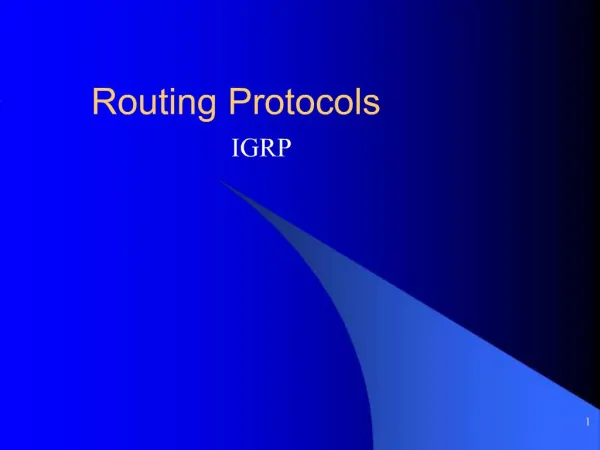
11/5/2012. 2. Network Layer Basics . Routers can be used to connect two or more networks.Routers examine incoming data packets and make path selections based on information stored in their routing tables.Routers can have more than one internet protocol (IP) address because it is attached to more t
547 views • 42 slides

Unicast Routing Protocols. Outline. Routing basic RIP OSPF BGP. Routing Basic. IP Routing Autonomous System (AS) IGP/EGP Distance-vector(DV)/Link-state(LS) How routing protocol works?. IP Routing. Route entry Destination/netmask Nexthop Longest-match Default-route
1.03k views • 58 slides

Routing Protocols. Heng Sovannarith heng_sovannarith@yahoo.com. Introduction. Routing protocols were created for routers. These protocols have been designed to allow the exchange of routing tables, or known networks, between routers.
318 views • 7 slides

Routing Protocols. Distributed Routing Protocols. Rtrs exchange control info Use it to calculate forwarding table Two basic types distance vector ( DECnet, “ old ” ARPANET, RIP ) link state (“ n ew ” ARPANET 1980, DECnet Phase V 1985 , IS-IS 1988 , OSPF version 2 1998 ). cost 2. j. m.
408 views • 26 slides

Routing Protocols. There are 2 classes of routing protocols:. . Finds the best path to a remote network by judging distance. The route with the least number of hops to the network is determined to be the best route. .
472 views • 27 slides
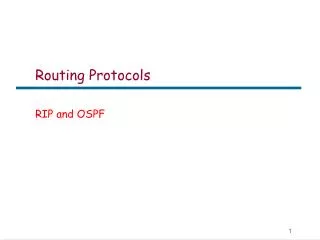
Routing Protocols. RIP and OSPF. Introduction - IP Protocol. Classful IP Addresses. IP address IPv4: 32-bit address dotted-quad or dotted decimal ex. 130.221.203.154 decimal = 82.DD.CB.9A hex = 1000 0010 . 1101 1101 . 1100 1011 . 1001 1010 binary
510 views • 26 slides

Routing Protocols. A router ‘knows’ only of networks attached to it directly – unless you configure a static route or use routing protocols Routing protocols share this information among immediate neighbors first, and then throughout the network
889 views • 36 slides
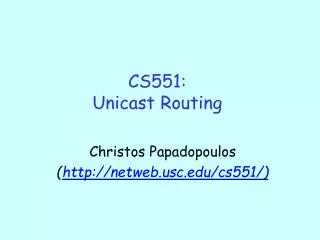
CS551: Unicast Routing. Christos Papadopoulos ( http://netweb.usc.edu/cs551/). Forwarding V.S. Routing. Forwarding : the process of moving packets from input to output based on: the forwarding table information in the packet
771 views • 55 slides

Routing Protocols. RIP, OSPF, BGP. A Routing Protocol’s Job Is to Find a “Best” Path between Any Pair of Nodes. Routers in a network exchange their routing information using a routing protocol. A routing table is set up in every router.
582 views • 33 slides

ROUTING PROTOCOLS. Rizwan Rehman. Static routing. each router manually configured with a list of destinations and the next hop to reach those destinations ideal for small number of destinations or “stub” networks stub network - network with only one or two paths to the rest of the network.
231 views • 11 slides
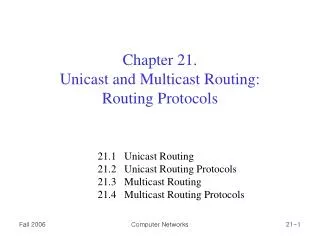
Chapter 21 . Unicast and Multicast Routing: Routing Protocols. 21.1 Unicast Routing 21.2 Unicast Routing Protocols 21.3 Multicast Routing 21.4 Multicast Routing Protocols. Routing Protocols. A router consults a routing table when a packet is ready to be forwarded
2.47k views • 49 slides
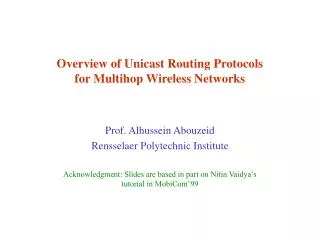
Overview of Unicast Routing Protocols for Multihop Wireless Networks. Prof. Alhussein Abouzeid Rensselaer Polytechnic Institute Acknowledgment: Slides are based in part on Nitin Vaidya’s tutorial in MobiCom’99. Controlling Flooding Using Location Information. 2. Flooding of Control Packets.
375 views • 21 slides

Routing Protocols. A Review of Current Routing Protocols for Ad Hoc Mobile Wireless Networks. Introduction. Mobile Wireless Networks Infrastructured Fixed and Wired Gateways Connecting to the nearest Base Station Ad hoc No Fixed Routers Moving Nodes Dynamic Connections Routing Protocols
1.06k views • 84 slides

Chapter 14. Routing Protocols. RIP, OSPF, BGP. Figure 14-1. Autonomous systems. Figure 14-2. Popular routing protocols. Link State. Distance Vector. Path Vector. Distance Vector Routing. Forouzan + CCNA: Slow convergence. Routing loops. Counting to infinity. Split horizon
1.32k views • 82 slides

Routing protocols. 1. Introduction. A routing protocol is the communication used between routers. A routing protocol allows routers to share information about networks and their proximity to each other. R outing Information Protocol (RIP) Interior Gateway Routing Protocol (IGRP)
303 views • 11 slides
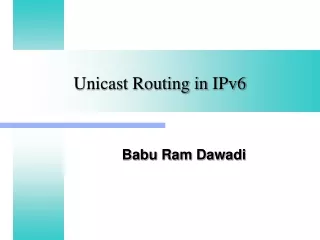
Unicast Routing in IPv6. Babu Ram Dawadi. Unicast Routing Protocol. Unicast routing is a process that enable sender to send an unicast IP packets to the destination node. 1 router or more intermediate routers may be used, depending to the destination of the node. (Figure 1)
583 views • 56 slides